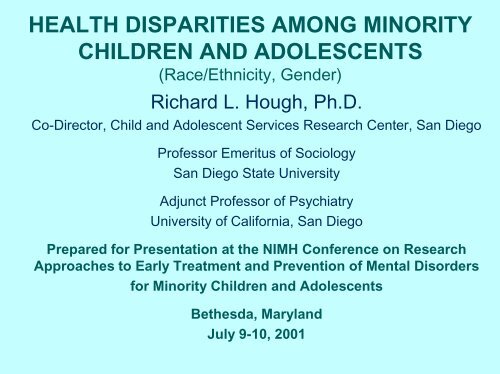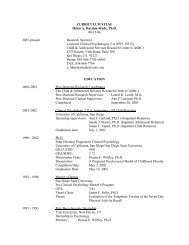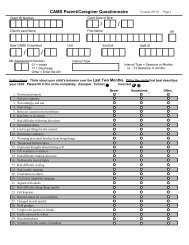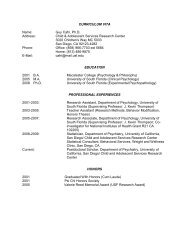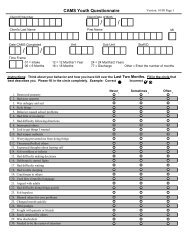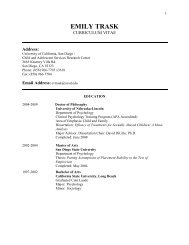Patterns of Care Presentation - Child and Adolescent Services ...
Patterns of Care Presentation - Child and Adolescent Services ...
Patterns of Care Presentation - Child and Adolescent Services ...
Create successful ePaper yourself
Turn your PDF publications into a flip-book with our unique Google optimized e-Paper software.
HEALTH DISPARITIES AMONG MINORITY<br />
CHILDREN AND ADOLESCENTS<br />
(Race/Ethnicity, Gender)<br />
Richard L. Hough, Ph.D.<br />
Co-Director, <strong>Child</strong> <strong>and</strong> <strong>Adolescent</strong> <strong>Services</strong> Research Center, San Diego<br />
Pr<strong>of</strong>essor Emeritus <strong>of</strong> Sociology<br />
San Diego State University<br />
Adjunct Pr<strong>of</strong>essor <strong>of</strong> Psychiatry<br />
University <strong>of</strong> California, San Diego<br />
Prepared for <strong>Presentation</strong> at the NIMH Conference on Research<br />
Approaches to Early Treatment <strong>and</strong> Prevention <strong>of</strong> Mental Disorders<br />
for Minority <strong>Child</strong>ren <strong>and</strong> <strong>Adolescent</strong>s<br />
Bethesda, Maryl<strong>and</strong><br />
July 9-10, 2001
INTRODUCTION<br />
• Disclaimers<br />
1. Will focus on estimates <strong>of</strong> the disparities in<br />
the prevalence <strong>of</strong> mental health problems <strong>and</strong><br />
mental health services among minority<br />
children <strong>and</strong> adolescents<br />
2. Not including disparities in general health<br />
3. Not including disparities by gender<br />
4. Not including the question <strong>of</strong> what “minority<br />
status” means in regard to health disparities
FOCUS<br />
• Cannot summarize all research literature on<br />
racial/ethnic variations in mental health problems <strong>and</strong><br />
services in 20 minutes. Therefore, focus mostly on:<br />
1. Relatively Recent Studies<br />
- roughly the last decade<br />
2. Estimates <strong>of</strong> Unmet Needs<br />
- the proportion <strong>of</strong> those in a population with<br />
diagnosable level mental disorder who do not<br />
receive mental health services<br />
3. DSM Based Diagnostic Studies<br />
- in which the prevalence <strong>of</strong> mental disorder is<br />
assessed by a survey research protocol yielding<br />
DSM diagnoses (e.g., DISC, CAPA, CIDI) as<br />
opposed to more traditional symptom <strong>and</strong> diagnostic<br />
interviews (e.g., CBCL, Rutter Scales, etc.)
ADMINISTRATIVE DATA STUDIES<br />
1. Los Angeles County Dept. <strong>of</strong> Mental Health, 1983-1988<br />
(Bui & Takeuchi, 1992; Takeuchi et al., 1993)<br />
Sample:<br />
853 African American, 704 Asian American,<br />
964 Hispanic, <strong>and</strong> 607 White clients<br />
Significant findings when “minority” compared to White<br />
# in system: Asian American & Hispanic under-represented<br />
African American over-represented<br />
Dropouts:<br />
Length <strong>of</strong><br />
Treatment:<br />
OP Episodes:<br />
Referral<br />
Source:<br />
No differences<br />
African American stay shortest time<br />
Asian American stay longest time<br />
African American have more<br />
African American more by school/legal<br />
<strong>and</strong> less by family, mental health<br />
Asian American more by school<br />
<strong>and</strong> less by social/legal<br />
Mexican American more by school<br />
<strong>and</strong> less by social/legal
2. California Integration <strong>of</strong> <strong>Care</strong> (AB377) Program<br />
(Rosenblatt & Attkisson, 1992)<br />
Three County Program for the Integration <strong>of</strong> <strong>Care</strong> for Seriously<br />
Emotionally Disturbed Youth<br />
African Americans significantly over-represented<br />
relative to the general population<br />
Asian Americans are significantly under-represented<br />
relative to the general population<br />
3. Virginia Department <strong>of</strong> Mental Health, Mental Retardation<br />
<strong>and</strong> Substance Abuse <strong>Services</strong><br />
(Sheppard & Coleman, 2001)<br />
Analysis <strong>of</strong> 2803 out-<strong>of</strong>-Home Service Placements for Youth,<br />
ages 10-19<br />
Black youth more likely than white to be placed in<br />
correctional facilities <strong>and</strong> foster care<br />
White youth more likely than Black to be hospitalized
UPSTATE NEW YORK STUDY<br />
• Community sample <strong>of</strong> 766 youth 10-20 years <strong>of</strong> age (91% White)<br />
• Black youth disproportionately at risk for Separation Anxiety in<br />
younger children, CDD in older children.<br />
(Velez et al., 1989)<br />
• DISC-1 Dx (Mother or <strong>Child</strong>)<br />
(Cohen & Hasselbart, 1993)<br />
% Use Any<br />
% Any Dx MH Service*<br />
Black (N=61) 22 20<br />
White (N=699) 15 11<br />
* Any contact with psychiatrist, psychologist, social worker or CMHC<br />
• Redundancy between race, income <strong>and</strong> city residence makes sorting<br />
out <strong>of</strong> specific contribution impossible<br />
• Of 206 depressed children, 64% received pr<strong>of</strong>essional help. African<br />
American significantly less likely to receive pr<strong>of</strong>essional help <strong>and</strong><br />
antidepressants than White or Hispanic. (Wu et al., 2001)
AMERICAN INDIAN STUDIES<br />
• Flowers <strong>of</strong> Two Soils Study<br />
(Beiser et al., 1998; Dion et al., 1998)<br />
School based sample <strong>of</strong> 2 nd <strong>and</strong> 4 th graders:<br />
931 Native<br />
384 Non-Native<br />
Diagnostic: Depression <strong>and</strong> CD Scales<br />
drawn from CBCL & DISC<br />
As reported by <strong>Child</strong>ren,<br />
Parent, Teacher<br />
Non-Native rates higher for child <strong>and</strong> parent report <strong>of</strong><br />
depression. Trend for teachers to rate Native children<br />
higher on depression<br />
No difference in mean scores on child <strong>and</strong> parent report <strong>of</strong><br />
CD symptoms. Teachers rate Non-Native higher on CD
OTHER AMERICAN INDIAN STUDIES<br />
• Northern Plains Indian <strong>Adolescent</strong> Study<br />
(Beals et al., 1997; Novins et al., 2000)<br />
Sample: 109 adolescents who had participated in earlier school-based<br />
epidemiological project (45% <strong>of</strong> original sample)<br />
Diagnostic: DISC 2.1<br />
6 month prevalence = 21% (mostly disruptive)<br />
AI<br />
MECA<br />
Any Anxiety 5.5 12.3<br />
Any Depressive 4.7 4.3<br />
Any Disruptive 13.8 4.7<br />
ADHD 10.6 1.2<br />
CD 3.8 2.7<br />
ODD 2.9 1.9<br />
Any Substance 18.3<br />
Lifetime MH or Substance Abuse <strong>Services</strong> use = 39% <strong>of</strong> those with<br />
diagnosis
OTHER AMERICAN INDIAN STUDIES<br />
• Northern Plains Reservation Juvenile Detention Center<br />
(Duclos et al., 1998; Novins et al., 1999)<br />
Sample: 150 consecutive admissions, 12 years <strong>of</strong> age or older<br />
Diagnostic: DISC-C-2.3<br />
6-Month Used <strong>Services</strong> for:<br />
Prev. Subst. Emot.<br />
Any Disorder 48.7% 38.4% 28.8%<br />
Anx/Dep 15.3% 39.1% 47.8%<br />
Disruptive 21.3% 50.0% 34.4%<br />
Substance use 38.0% 40.0% 26.3%
PRIMARY CARE STUDIES<br />
• Costello et al.<br />
789 consecutive visits to 2 pediatric clinics, 1984-85<br />
Ages 7-11<br />
Diagnostics: CBCL Screen <strong>and</strong> DISC-P<br />
Prevalence:<br />
11.8% by DISC-P<br />
13.8% by DISC-C<br />
5.7% by Clinician Dx.<br />
Mostly ADD, OD, CD, Separation Anxiety<br />
Service Use:<br />
3.6% <strong>of</strong> sample used mental health services in last year<br />
7% <strong>of</strong> those with diagnosis were referred to mental health<br />
services
PRIMARY CARE STUDIES<br />
• Briggs-Gowan et al., 2000<br />
1060 consecutive admissions <strong>of</strong> children, ages 5-9, to<br />
23 pediatric practices in New Haven (82% White)<br />
16.8% with DISC-P Diagnosis<br />
21.1% talked to a Pediatrician<br />
10.5% saw a mental health pr<strong>of</strong>essional<br />
Being <strong>of</strong> ethnic minority not significantly associated<br />
with talking to Pediatrician or visiting a mental health<br />
pr<strong>of</strong>essional<br />
• Kelleher et al., 1999
THE MECA STUDIES<br />
N=1285<br />
SITES<br />
1. ATLANTA, GEORGIA (N=299)<br />
Emory (M.K. Dulcan, B.B. Lahen, D.J. Brogan, & S.H. Goodman)<br />
2. WESCHESTER COUNTY, NEW YORK (N=369)<br />
Columbia (H. Bird, D. Shaffer, M. Weissman, P. Cohen, D. K<strong>and</strong>el, C. Hoven, M.<br />
Davies, M. Gould, & A. Whitaker)<br />
3. THREE TOWNS ADJACENT TO NEW HAVEN, CONNECTICUT (N=314)<br />
Yale (M. Scwab-Stone, P.J. Leaf, S.M. Horwitz, J.H. Lichtman)<br />
4. SAN JUAN, PUERTO RICO (N=312)<br />
University <strong>of</strong> Puerto Rico (G. Canino, M. Rubio-Stipec, M. Bravo, M. Alegria, J.<br />
Bauerminster, J. Ribera, S. Huertas, M. Woodbury)
PERCENTAGE OF YOUTH<br />
Receiving Specialty Mental Health <strong>Services</strong><br />
in Past Year by DISC Diagnosis<br />
Any Disc Dx Disc Dx + CGAS < 61<br />
% N % N<br />
Atlanta 13.4 112 21.3 47<br />
New Haven 16.5 115 26.4 53<br />
New York 25.0 100 29.0 38<br />
Puerto Rico 9.2 87 25.0 8<br />
Total 16.2 414 25.3 146<br />
Leaf et al., 1996<br />
No direct information re: racial/ethnic differences<br />
Differences in Puerto Rico due to differential functioning <strong>of</strong> CGAS resulting in lower rates<br />
<strong>of</strong> diagnosis & differences in specialty mental health care system.
OTHER MECA DATA<br />
Goodman et al., 1997<br />
535 received DISC diagnosis (without regard to CGAS)<br />
Of those percentages receiving outpatient specialty mental health services:<br />
Flischer et al., 1997<br />
18% <strong>of</strong> mainl<strong>and</strong> Non-Hispanic Whites;<br />
9% <strong>of</strong> African Americans;<br />
11% <strong>of</strong> other mainl<strong>and</strong> ethnic minorities;<br />
8% <strong>of</strong> those in Puerto Rico<br />
Of 269 with DISC diagnosis <strong>and</strong> CGAS impairment, 49 (18.2%) had mental health<br />
services in last 6 months.<br />
87.5% had “unmet need.”<br />
Unmet need significantly higher among Blacks, though rate cannot be determined<br />
from the presentation.<br />
Overall Implication:<br />
Among those in need, there is a significant disparity in receipt <strong>of</strong> mental health<br />
services by:<br />
Mainl<strong>and</strong> African Americans:<br />
Puerto Ricans residing in Puerto Rico;<br />
Other mainl<strong>and</strong> ethnic minorities
PREVALENCE OF SERIOUS EMOTIONAL<br />
DISTURBANCE<br />
(Costello et al., 1998)<br />
• Re-analysis <strong>of</strong> 7 community studies:<br />
1) Boston: 383 youth 17-19, 99% Non-<br />
Hispanic White<br />
2) Pittsburgh, Wave 1: N=386, Ages 7-11, 18% Black<br />
3) Pittsburgh, Wave 2: N=263, Ages 12-18, 16% Black<br />
4) Puerto Pico: N=386, Ages 4-16, 100% Latino<br />
5) New York State: N=764, Ages 9-18, 91% White<br />
6) North Carolina: N=1071, Ages 9-16, 91% White<br />
7) North Carolina American Indian: N=346, Ages 9-16, 100%<br />
Cherokee<br />
• SED = Psychiatric Diagnosis (DISC, CAPA) + Significant<br />
Functional Impairment (CBCL, CAPA)<br />
• No clear racial/ethnic differences on SED with either global or<br />
domain specific impairment
GREAT SMOKY MOUNTAIN STUDY<br />
Community Sample<br />
1429 children, ages 9, 11, <strong>and</strong> 13 years<br />
White = 933<br />
American Indian = 323<br />
African American = 93<br />
Prevalence <strong>of</strong> any current CAPA assessed disorder<br />
White = 19.2%<br />
American Indian = 16.7%<br />
African American + 34.3 %<br />
Overall, no statistical difference in prevalence between White <strong>and</strong><br />
American Indian samples <strong>and</strong> sample size for African Americans is too<br />
small to yield robust estimate.<br />
(Costello et al., 1996; Costello et al., 1997)
MENTAL HEALTH SERVICES USE IN THE GREAT<br />
SMOKY MOUNTAIN STUDY<br />
Use <strong>of</strong> pr<strong>of</strong>essional mental health care services among those with a CAPA current<br />
diagnosis:<br />
(Costello et al., 1996; Costello et al., 1997)<br />
White: 1 in 8<br />
American Indian: 1 in 7<br />
Use <strong>of</strong> specialty mental health care sector:<br />
(Burns et al., 1995)<br />
White: 4.1%<br />
African American: 2.9%<br />
Use <strong>of</strong> any sector (Mental Health, Education, Health, <strong>Child</strong> Welfare, Juvenile Justice)<br />
(Burns et al., 1995; Farmer et al., 1999)<br />
White: 16.3%<br />
African American: 18.7%<br />
Receipt <strong>of</strong> services in the Education Sector by far the most common<br />
White respondents over-represented in <strong>Child</strong> Welfare<br />
American Indian children over-represented in Juvenile Justice <strong>and</strong> Primary <strong>Care</strong>
PATTERNS OF CARE<br />
Participating Institutions <strong>and</strong> Agencies<br />
<strong>Child</strong>ren’s Hospital <strong>and</strong> Health Center, San Diego<br />
<strong>Child</strong> <strong>and</strong> <strong>Adolescent</strong> <strong>Services</strong> Research Center,<br />
<strong>Child</strong>ren’s Hospital Foundation Center for Research,<br />
Institute <strong>of</strong> Psychiatry, Center for <strong>Child</strong> Protection<br />
San Diego State University<br />
Department <strong>of</strong> Psychology, Sociology<br />
Schools <strong>of</strong> Social Work, Public Health<br />
University <strong>of</strong> California, San Diego<br />
Departments <strong>of</strong> Psychiatry, Psychology<br />
San Diego County Mental Health <strong>Services</strong><br />
San Diego County Juvenile Probation<br />
San Diego County <strong>Child</strong>ren’s <strong>Services</strong> Bureau<br />
San Diego County Drug <strong>and</strong> Alcohol <strong>Services</strong><br />
San Diego City Schools SED Programs<br />
Funded by: National Institute <strong>of</strong> Mental Health<br />
Funding Dates: 7/1/96 to 6/30/01
PATTERNS OF CARE INVESTIGATORS AND KEY STAFF<br />
Principal Investigator: R. L. Hough, Ph.D. Co-Principle Investigator: J. A. L<strong>and</strong>sverk, Ph.D.<br />
Co-Investigators:<br />
S. Brown, Ph.D.<br />
S. Culver, L.C.S.W.<br />
I. Davis, Ph.D.<br />
A. Garl<strong>and</strong>, Ph.D.<br />
A. Hazen, Ph.D.<br />
Statistics <strong>and</strong> Data Analysis:<br />
M. Hurlburt, Ph. D.<br />
R. Newton, Ph.D.<br />
D. Slymen, Ph.D.<br />
P. Wood, M.A., M.P.H.<br />
J. Gearity, M.S.W.<br />
Other Key Support Staff:<br />
J. Covert<br />
T. Ganger<br />
V. Mazon<br />
M. Mendez<br />
V. Renker<br />
.<br />
Other Investigative Staff:<br />
S.Levine, M.D.<br />
A. Litrownik, Ph.D.<br />
J. Price, Ph.D.<br />
Post-Doctoral Research<br />
Associates:<br />
G. Aarons, Ph.D.<br />
K. McCabe, Ph.D.<br />
F. Soriano, Ph.D.<br />
M. Yeh, Ph.D.<br />
Scientific Advisory Committee:<br />
S. Barnett, Ph.D., Rutgers University<br />
G. Canino, Ph. D., University <strong>of</strong> Puerto Rico<br />
J. Christianson, Ph.D., University <strong>of</strong> Minnesota<br />
P. Fisher, M.A., Columbia University<br />
D. Shaffer, M.D., Columbia University<br />
L. Teplin, Ph.D., Northwestern University
SINGLE AND MULTIPLE USE BY SERVICE<br />
SYSTEM (Overall)<br />
Alcohol<br />
Drug<br />
N=374<br />
<strong>Child</strong><br />
Welfare<br />
N=12,663<br />
Mental<br />
Health<br />
N=5,408<br />
Juvenile<br />
Justice<br />
N=6,454<br />
SDUSD<br />
SED<br />
N=1,238<br />
Not open to<br />
any other<br />
system<br />
43.0% 86.5% 54.2% 84.5% 51.5%<br />
Open to<br />
one other<br />
system<br />
Open to<br />
two other<br />
systems<br />
Open to<br />
three or<br />
more other<br />
systems<br />
38.2% 11.9% 40.3% 12.7% 33.1%<br />
16.9% 1.5% 5.1% 2.4% 14.4%<br />
1.9% 0.1% 1.4% 0.2% 1.0%<br />
Total 100% 100% 100% 100% 100%
RACIAL/ETHNIC SECTOR<br />
REPRESENTAION IN PUBLIC YOUTH SERVICES<br />
% <strong>of</strong> 200%<br />
% <strong>of</strong> Poverty Under/Over<br />
Racial/Ethnic Group & Sector Sector Population Representation<br />
African Americans (N=2539<br />
Alcohol/Drug .09 .11<br />
<strong>Child</strong> Welfare .29 .11*** Over<br />
Mental Health .18 .11*** Over<br />
Juvenile Justice .20 .11*** Over<br />
SED .25 .11*** Over<br />
Asian/Pacific Isl<strong>and</strong>ers (N=546)<br />
Alcohol/Drug .11 10<br />
<strong>Child</strong> Welfare .03 .10*** Under<br />
Mental Health .05 10*** Under<br />
SED .02 .10*** Under<br />
Caucasian Americans (N=4642)<br />
Alcohol/Drug .42 .30*** Over<br />
<strong>Child</strong> Welfare .41 .30*** Over<br />
Mental Health .42 .30*** Over<br />
Juvenile Justice .28 .30<br />
SED .57 .30*** Over<br />
Latinos (N=3421)<br />
Alcohol/Drug .38 .48*** Under<br />
<strong>Child</strong> Welfare .25 .48*** Under<br />
Mental Health .31 .48*** Under<br />
Juvenile Justice .40 .48*** Under<br />
SED .15 .48*** Under
RACIAL/ETHNIC GROUP ODDS RATIOS FROM LOGISTIC<br />
REGRESSIONS FOR REFERRAL SOURCE TO MENTAL<br />
HEALTH SERVICES*<br />
African American Asian/Pacific Isl<strong>and</strong>er Latino<br />
<strong>Child</strong> Welfare (N=930) 1.2 1.8* .9<br />
Crisis .9 .6 1.2<br />
Family (N=721) 1.2 .7 1.5*<br />
Juvenile Justice (N=126) 1.1 .4 1.1<br />
Mental Health .9 .8 .6*<br />
Agency (N=544)<br />
School (N=713) .6* .8 1.0<br />
*Non-Hispanic Whites is reference group. Controlling for age, gender, GAF Scores <strong>and</strong> prior county mental health service use.
RACIAL/ETHNIC GROUP ODDS RATIOS FROM LOGISTIC<br />
REGRESSIONS FOR CLINICIAN-ASSIGNED DIAGNOSES IN<br />
MENTAL HEALTH SERVICES*<br />
African American Asian/Pacific Isl<strong>and</strong>er Latino<br />
Adjustment (N=485) 1.2 1.4 1.6<br />
Anxiety (N=221) .8 .8 1.5*<br />
ADHD (N=678) .9 .5* .6*<br />
Disruptive 1.0 .7 1.1<br />
Behavior (N=594)<br />
Impulse Control (N=170) .7 .4 .8<br />
Mood (N=789) .7* .9 .9<br />
Psychotic (N=69) 1.0 2.9 1.9<br />
Substance Related (N=57) .8 1.7 1.4<br />
V-Code (N=532) 1.3* 2.0* .9<br />
*Non-Hispanic Whites is reference group. Controlling for age, gender, GAF Scores <strong>and</strong> prior county mental health service use.
RACIAL/ETHNIC GROUP ODDS RATIOS FROM LOGISTIC<br />
REGRESSIONS FOR TYPES OF SERVICES RECEIVED FROM<br />
MENTAL HEALTH SERVICES*<br />
African American Asian/Pacific Isl<strong>and</strong>er Latino<br />
Crisis (N=324) .8 .8 1.1<br />
Special Education Mental .5* .2* 1.0<br />
Health Assessment<br />
Outpatient Clinic (N=1632) 1.0 1.0 1.6*<br />
Outpatient Institutional 1.4* 1.5 .9<br />
(N=1388)<br />
Case Management (N=187) 1.0 .8 .7<br />
Intensive Case 1.5 2.4 1.1<br />
Management (N=47)<br />
Day Treatment (N=175) .5* .5 .4*<br />
*Non-Hispanic Whites is reference group. Controlling for age, gender, GAF Scores <strong>and</strong> prior county mental health service use.
POC SURVEY<br />
• SAMPLING FRAME = ENUMERATION<br />
DATA FOR 1996-1997 FISCAL YEAR<br />
• N = 1715<br />
• AGES = 6-18<br />
• IN PERSON INTERVIEWS CONDUCTED<br />
WITH YOUTH & CLOSEST CAREGIVER
POC SAMPLING FRAME<br />
• All youth 6-17 years <strong>of</strong> age<br />
• Active in fiscal year 1996-1997<br />
• In one or more <strong>of</strong> five public sectors <strong>of</strong> care in<br />
San Diego County:<br />
! Mental Health <strong>Services</strong>: All open cases<br />
! School SED <strong>Services</strong>: All open cases<br />
! Juvenile Justice: All wards <strong>of</strong> the court<br />
! Alcohol-Drug <strong>Services</strong>: All open cases<br />
! <strong>Child</strong> Welfare: All youth under court<br />
jurisdiction & in<br />
foster care, kinship care, or<br />
other out-<strong>of</strong>-home placement
RACE/ETHNICITY<br />
7%<br />
5%<br />
3%<br />
37%<br />
Caucasian<br />
Black<br />
Latino<br />
28%<br />
Asian/Pac<br />
Isl<strong>and</strong>er<br />
Mixed<br />
Other/Unknown<br />
20%
GENDER<br />
34%<br />
Male<br />
Female<br />
66%
AGE<br />
27%<br />
44%<br />
6-11 Years<br />
12-15 Years<br />
16-18 Years<br />
29%
SERVICE SECTOR<br />
15%<br />
3%<br />
33%<br />
Alcohol-Drug<br />
<strong>Child</strong> Welfare<br />
Juvenile<br />
Justice<br />
Mental Health<br />
54%<br />
School SED<br />
30%<br />
*Numbers <strong>of</strong> youth in multiple service sectors
PREVALENCE OF DIAGNOSES WITH IMPARIMENT,<br />
ADULT OR YOUTH INFORMANT<br />
Diagnosis Race-Ethnicity <strong>of</strong> Youth Total b<br />
Latino White OR Black OR Asian/PI OR<br />
(n=336) (n=463) (n=256) (n=109) (N=1164)<br />
Any Study 48.3 64.3 1.9*** 47.4 1.0 45.3 .9 53.7<br />
Disorder a<br />
Any Disruptive 42.9 60.8 2.1*** 43.9 1.1 38.3 .8 49.3<br />
Disorder<br />
Any Anxiety 8.9 10.9 1.2 8.3 1.0 9.5 1.2 8.8<br />
Disorder<br />
(n=307) (n=396) (n=236) (n=99) (n=1038)<br />
Any Mood 8.3 5.5 .6 3.6 .4* 12.8 1.6 6.6<br />
Disorder<br />
*p
SERVICE USE PAST YEAR FOR YOUTHS WITH ONE OR<br />
MORE DISC DIAGNOSES<br />
Service Use Past Year Race-Ethnicity <strong>of</strong> Youth<br />
% (weighted) youths Latino White OR Black OR Asian/PI OR<br />
received services: (n=174) (n=397) (n=128) (n=49)<br />
Total b<br />
(N=658)<br />
School-based 63.9 69.9 1.3 65.8 1.1 53.5 .7 66.2<br />
Outpatient treatment<br />
Specialty MH a 55.1 73.1 2.2*** 50.8 .8 37.2 .5* 60.8<br />
Non-specialty MH b 18.1 23.6 1.4 18.3 1.0 20.9 1.1 20.7<br />
Informal MH c 31.3 38.2 1.4 24.2 .7 32.6 1.1 33.0<br />
*p
INPATIENT SERVICE USE PAST YEAR FOR YOUTHS<br />
WITH ONE OR MORE DISC DIAGNOSES<br />
Service Use Past Year Race-Ethnicity <strong>of</strong> Youth<br />
Total b<br />
% (weighted) youth Latino White OR Black OR Asian/PI OR<br />
received services: (n=174) (n=397) (n=128) (n=49) (N=658)<br />
24-hour care<br />
Specialty MH a 6.0 11.2 2.0 4.1 .7 2.4 .5 7.7<br />
Non-specialty MH b 12.0 18.1 1.6 21.7 1.9 9.3 .8 16.5<br />
Informal MH c 6.0 7.3 1.2 3.3 .5 0 __ 5.6<br />
*p
PREVALENCE OF DIAGNOSES a WITH IMPAIRMENT<br />
FOR LATINO YOUTH 12 AND OLDER BY CULTURAL STATUS<br />
Diagnosis Cultural Status – Youth Pan Total<br />
Bicultural Americanized OR Other Culture OR<br />
(n=114) (n=96) (n=83))<br />
(N=311)<br />
Any Study 52.8 45.7 .7 39.8 .6 46.5<br />
Disorder<br />
Any Disruptive 48.4 43.2 .8 28.4 .4** 40.9<br />
Disorder<br />
Any Anxiety 7.8 9.5 1.3 12.6 1.8 9.1<br />
Disorder<br />
(n=93) (n=107) (n=80) (n=297)<br />
Any Mood 7.0 14.4 2.3 5.7 .8 8.5<br />
Disorder<br />
*p
SERVICE USE PAST YEAR FOR YOUTHS WITH A DISC<br />
DIAGNOSES<br />
Service Use, past year Cultural Status – Youth PAN Total<br />
% (weighted) youth Bicultural a Americanized OR Other Culture OR<br />
received services: (n=50) (n=57) (n=42) (N=157)<br />
School-based 60.0 65.1 1.2 65.7 1.3 63.1<br />
Outpatient Treatment<br />
Specialty MH a 55.4 65.9 1.5 40.0 .5 55.3<br />
Non-specialty MH b 14.1 25.6 2.1 17.1 1.3 19.6<br />
Informal MH c 31.3 31.8 1.0 36.1 1.2 32.0<br />
*p
INPATIENT SERVICE USE PAST YEAR<br />
FOR YOUTHS WITH A DISC DIAGNOSES<br />
Service Use, past year Cultural Status – Youth PAN Total<br />
% (weighted) youths Bicultural a Americanized OR Other Culture OR<br />
received services: (n=50) (n=57) (n=42) (N=157)<br />
24-hour care<br />
Specialty MH a 3.1 11.4 3.9 8.6 2.9 6.7<br />
Non-specialty MH b 12.3 14.0 1.2 11.4 1.0 12.8<br />
Informal MH c 6.2 9.3 1.6 5.7 1.3 6.7<br />
*p
EARLY CHILDHOOD (Age 6-12)<br />
CONDUCT DISORDER AND SYMPTOMS<br />
Percent with CD Symptoms or Diagnosis<br />
No CD 1+ CD CD Total<br />
Symptoms Symptoms Diagnosis<br />
Caucasian 39 33 28 197<br />
African American 57 29 14 83<br />
Latino 62 29 10 52<br />
Asian/Pacific Isl<strong>and</strong>er 87 12 __ 8<br />
Biracial 37 47 21 62
PREVALENCE OF ADOLESCENT SUBSTANCE USE<br />
DISORDERS<br />
Caucasian African Latino Asian/ Total<br />
American Pacific Isl<strong>and</strong>er<br />
(n=353) (n=214) (n=299) (n=97) (N=963)<br />
Any Substance<br />
Lifetime 43.7 26.8*** 42.4 47.7 39.8<br />
Past Year 28.1 17.2** 25.1 21.4 24.8<br />
Alcohol<br />
Lifetime 38.9 17.4*** 33.4 33.7 31.5<br />
Past Year 23.3 12.4** 18.2 21.4 18.9<br />
Cannabis<br />
Lifetime 28.9 19.5*** 29.0 27.1 26.6<br />
Past Year 12.6 8.8 12.0 10.5 11.3<br />
Amphetamine<br />
Lifetime 18.1 1.5*** 14.7 18.8 13.2<br />
Past Year 7.7 1.0** 7.7 10.5 6.4<br />
Hallucinogen<br />
Lifetime 10.1 0.5** 3.6** 8.1 5.5<br />
Past Year 2.3 __ 1.6 3.5 1.7<br />
Cocaine & Opiate Too few to report<br />
Caucasians are the reference group for race/ethnicity comparisons<br />
***Significantly lower prevalence than reference group at the .001 level.<br />
**Significantly lower prevalence than reference group at the .01 level.
POC ADOLESCENT MENTAL<br />
DISORDER/SUBSTANCE ABUSE COMORBIDITY<br />
No Dx w/o SUD DISC No Dx w/<br />
Impairment Only Only Comorbid impairment<br />
(n=66) (n=408) (n=183) (n=183) (n=164)<br />
Caucasian 28.2 36.3 41.2 25.0 22.1<br />
African American 21.7 21.4 12.3 22.8 26.8<br />
Latino 37.3 26.0 31.3 37.2 34.1<br />
Other 12.7 16.2 15.1 15.1 17.0<br />
From Aarons et al., in preparation
BETA WEIGHTS FOR PREDICTORS OF USE OF<br />
SERVICES FOR SUBSTANCE ABUSE PROBLEMS<br />
Outpatient<br />
Inpatient Juvenile Justice<br />
RTC Involvement<br />
Age .5 1.2* 1.3***<br />
Gender .3 .5 1.5***<br />
Race:<br />
Caucasian<br />
African American -.3 1.3*** .5*<br />
Latino -.3 .9 -.01<br />
Other -.5 .7 -.2<br />
C-GAS
GENDER DIFFERENCES IN PREVALENCE OF<br />
PSYCHIATRIC DISORDERS AMONG ADJUDICATED<br />
DELINQUENTS IN THE JUVENILE JUSTICE SECTOR<br />
(n=625)<br />
% Female % Males F<br />
Any DISC-IV Diagnosis 64.4 49.3 3.9*<br />
Any DISC-IV Mood Disorder 15.8 4.9 12.1***<br />
Any DISC-IV Anxiety Disorder 14.6 7.9 2.4<br />
Any DISC-IV Disruptive Disorder 63.5 49.2 4.4*<br />
ADHD 21.0 15.1 1.2<br />
CD 38.2 32.8 .7<br />
ODD 41.5 30.3 3.1<br />
*p


